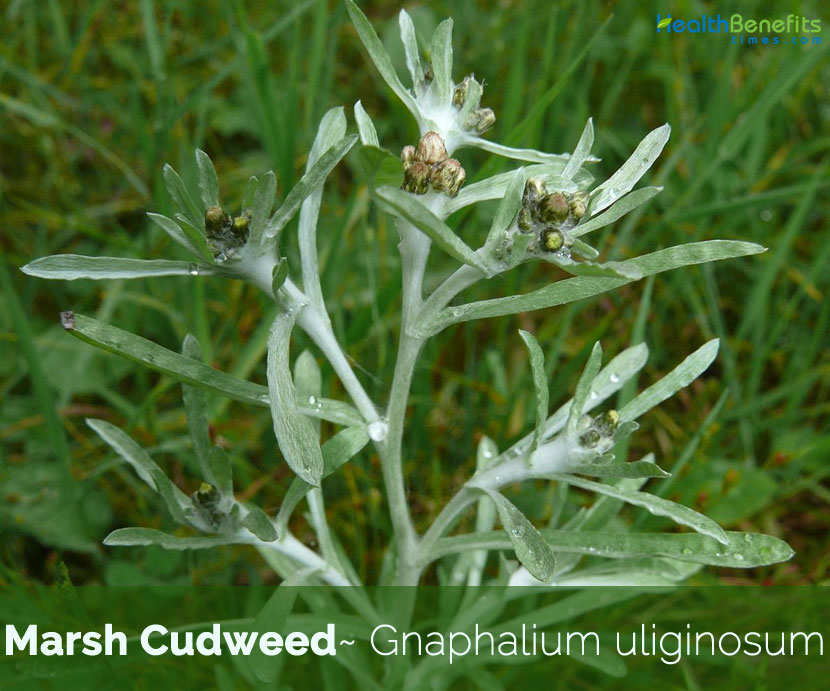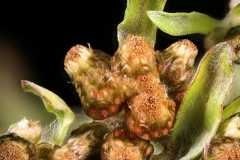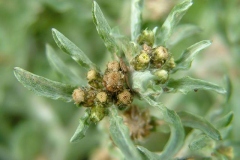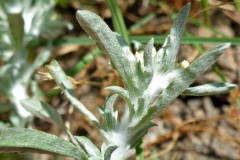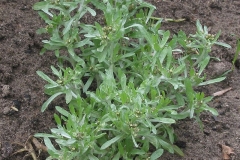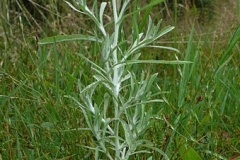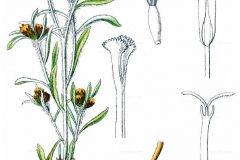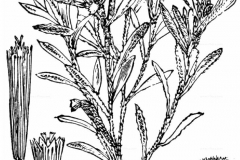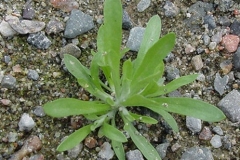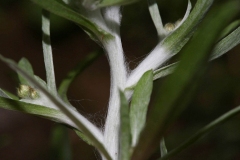| Marsh Cudweed Quick Facts | |
|---|---|
| Name: | Marsh Cudweed |
| Scientific Name: | Gnaphalium uliginosum |
| Origin | Widespread across much of Europe, Asia, and North America |
| Shapes | Small achenes, nerveless |
| Taste | Bitter, pungent |
| Health benefits | Beneficial for laryngitis, upper respiratory catarrh, tonsillitis, high blood pressure, lung problems, leucorrhea, hemorrhage, sciatica, lumbago, arthritis |
| Name | Marsh Cudweed |
|---|---|
| Scientific Name | Gnaphalium uliginosum |
| Native | Widespread across much of Europe, Asia, and North America |
| Common Names | Cudweed, Low cudweed, Marsh cudweed, Mouse-ear, Mud cudweed, brown cudweed, wayside cudweed |
| Name in Other Languages | Afrikaans: Cudweed Albanian: Cudweed Amharic: T’elefe (ጠለፈ) Arabic: Tahlab (طحلب) Armenian: Kokord (կոկորդ) Azerbaijani: Cudweed, Bataqlıq qurucası Bashkir: Кипкәр Bengali: Cudweed Bulgarian: Byal smil (бял смил), blagolyubiv byal smil (благолюбив бял смил) Burmese: Cudweed Catalan: Gnafali uliginós Chinese: Zhū cǎo (猪草), shī shēng shǔ qū cǎo (湿生鼠麴草) Croatian: Cudweed Czech: Pudink, protěž bažinná Danish: Cudweed, Almindelig Hør, Krans-Lilje, Sump-evighedsblomst, Vild Tulipan, Østrigsk Hør, Sump-evighedsblomst, sumpevigedsblomst Dutch: Cudweed, Moerasdroogbloem English: Cudweed, Low cudweed, Marsh cudweed, Mouse-ear, Mud cudweed, brown cudweed, wayside cudweed Esperanto: Cudweed Estonian: Kaisukaru, Soo-kassiurb Filipino: Cudweed Finnish: Cudweed, Peltopellava, Tiikerililja, Varjolilja, Savijäkkärä French: Cudweed, Cotonnière des fanges, Gnaphale des fanges, Gnaphale des marais, Gnaphale des mares, Gnaphale des vases, Cotonnière des marais, Gnaphale uligineuse, filaginelle des marais, gnaphale des lieux humides, gnaphale fangeux, gnaphale uligineux, immortelle des marais Georgian: Sidukhch’ire (სიდუხჭირე) German: Cudweed, Sumpf-Ruhrkraut, Sumpfruhrkraut Greek: Ankaliá (αγκαλιά) Gujarati: Cudweed Hausa: Cudanya Hebrew: חרס Hindi: Cudweed Hungarian: Gyopár, Iszapgyopár Icelandic: Hvítlaukur, Grámygla Indonesian: Cudweed Irish: Cudweed, Gnamhlus corraigh Italian: Cudweed, Canapicchia palustre, gnafalio acquatico Japanese: Kaddou~īdo (カッドウィード), himechichikogusa (ヒメチチコグサ), ezonohahakogusa (エゾノハハコグサ) Javanese: Cudweed Kannada: Kaḍvīḍ (ಕಡ್ವೀಡ್) Kazakh: Qıdır (қыдыр) Korean: Daegu (대구), wae tteok ssuk (왜떡쑥) Kurdish: Cudweed Lao: Cudweed Latin: Cudweed Latvian: Cudweed, dumbrāja zaķpēdiņa Lithuanian: Pelėda, Pelkinis pūkelis Macedonian: Bradavica (брадавица) Malagasy: Cudweed Malay: Merangkak Malayalam: Cudweed Maltese: Cudweed Marathi: Cudweed Mongolian: Cudweed Nepali: Cudweed Northern Sami: Mohterádná Norwegian: Cudweed, Krøll-lilje, Lin, Villtulipan, Åkergråurt Oriya: କଦଳୀ Pashto: Cudweed Persian: نوازش Polish: Cudweed, Szarota błotna Portuguese: Cudweed, gnafa-cinzenta, gnafa-cinzenta Punjabi: Cudweed Romanian: Cudweed Russian: Sushenitsa (сушеница), Sushenitsa topyanaya (Сушеница топяная) Serbian: Cudveed (цудвеед), mrki srcopuc (мрки срцопуц) Sindhi: جذباتي ڪيو Sinhala: Cudweed Slovak: Bielolístok barinný Slovenian: Cudweed, močevna molova roža Spanish: Cudweed, močevna molova roža, gnaphalium de pantano, siempreviva de cumbres, siemprevivas de las cumbres, yerba de alcaudones, yerba de gorriones Sudanese: Cudweed Swedish: Cudweed, Klipplin, Krollilja, Lin, Tigerlilja, Vildtulpan, Savijäkkärä, Sumpnoppa Tajik: Cudweed Tamil: Cudweed Telugu: Cudweed Thai: Cudweed Turkish: Cudweed, bozağan Ukrainian: Sushenitsya (сушениця), Sukhotsvit bahnovyy (Сухоцвіт багновий) Urdu: Cudweed Uzbek: Yostiq Vietnamese: Cây tầm ma Welsh: Cudweed, Edafeddog y gors Zulu: Cudweed |
| Plant Growth Habit | Woolly annual |
| Growing Climates | Damp places in sandy fields, heaths, waysides, lake, pond margins, ephemeral pools, damp, arable grasslands, paths, shores, puddles, ditches, small roads, yards, wasteland, meadows, pastures |
| Plant Size | 3-15 cm. tall |
| Stem | Straight or slightly receding, unbranched or usually branched |
| Leaf | Leaves are up to 2 inches long, up to 1/8 inch wide, toothless, covered in white woolly hair, often a bit wavy around the edges, pointed at the tip with no leaf stalk |
| Flowering season | July to August |
| Flower | Very small about 3 to 4 mm long and crowded in small clusters of 3 to 10, near the ends of the branches and in axils of leaves, whitish to light brownish-green to straw-colored |
| Fruit Shape & Size | Elliptic, glabrous, brown, achene less than 1 mm (0.04 in.) long, tip with unbranched hairs. |
| Fruit Color | Brown |
| Taste | Bitter, pungent |
| Plant Parts Used | Bitter, pungent |
| Other Facts |
|
| Precautions |
|
Plant Description
Marsh Cudweed is a woolly annual plant normally growing about 5-20 cm. tall with short roots (5-18 cm). It is covered with tufted white tomentum, especially above, at anthodia. Stalk more or less branchy from the base. The plant is found growing in damp places in sandy fields, heaths, waysides, lake, pond margins, ephemeral pools, damp, arable grasslands, paths, shores, puddles, ditches, small roads, yards, wasteland, meadows, pastures, depressions in cultivated fields, streams, valleys, roadside ditches and grain fields.
Leaves
Leaves are alternate (1 per node) but numerous and appearing tufted near the tips of branches. Leaves are up to 2 inches long, up to 1/8 inch wide, toothless, covered in white woolly hair, often a bit wavy around the edges, pointed at the tip with no leaf stalk. Stems typically spread out from the base, making it wider than tall, and are also densely covered in woolly hairs, giving them a whitish cast.
Flowers
Flower heads very small about 3 to 4 mm long and crowded in small clusters of 3 to 10, near the ends of the branches and in axils of leaves, whitish to light brownish-green to straw-colored and look like buds or flowers that have already died back and turned brown, without ray florets; involucral bracts tiny, thin, papery, tan or light brownish. Flowering normally takes place in between July to August.
Fruit
Fertile flowers are followed by small achenes, nerveless. One plant produces 100 to 500 hemicarps; weight of 1000 seeds is 0.007 g.
Traditional uses and benefits of Marsh Cudweed
- Marsh cudweed is little used in modern herbalism, though it is occasionally taken for its astringent, antiseptic and anti-catarrhal properties.
- Whole plant is anti-inflammatory, astringent, diaphoretic and diuretic.
- It may also have aphrodisiac and anti-depressant effects.
- It is used both internally and externally in the treatment of laryngitis, upper respiratory catarrh and tonsillitis, whilst in Russia it is used in the treatment of high blood pressure.
- The plant is harvested when it is in flower and is dried for later use.
- It’s good for constipations and hemorrhoids in the form of therapeutic enema.
- Cudweed decoction is taken internally for thrombophlebitis.
- It is used topically for wounds, ulcers and burns.
- Gargle and mouthwash of cudweed is said to soothe throat irritations.
- In British herbal medicine, it is occasionally taken for tonsillitis, sore throat, and hoarseness, and for mucus in the throat, nasal passages, and sinuses.
- An infusion is useful for lung problems, leucorrhea and intestinal problems including hemorrhage.
- Cold infusion helps expel intestinal worms.
- Homeopathic tincture is used for sciatica, lumbago and some kinds of arthritis.
- Fresh juice is used to calm excessive sexual desire.
- It makes a good fomentation for bruises, wounds and ulcers.
- Dried flowers are used like hops for a calming herb pillow. As a mouthwash and gargle, the infusion is good for sores in mouth and throat.
- It is widely used in the treatment of hypertension, thrombophlebitis, phlebothrombosis and ulcers.
- Decoction and infusion of G. uliginosum are known to possess anti-inflammatory, astringent, and antiseptic properties.
- Oil extracts are used in the treatment of laryngitis, upper respiratory catarrh and tonsillitis.
References:
https://www.itis.gov/servlet/SingleRpt/SingleRpt?search_topic=TSN&search_value=502816#null
https://pfaf.org/user/Plant.aspx?LatinName=Gnaphalium+uliginosum
http://www.floracatalana.net/gnaphalium-uliginosum-l-
https://plants.usda.gov/core/profile?symbol=GNUL
https://npgsweb.ars-grin.gov/gringlobal/taxon/taxonomydetail?id=104248
https://en.wikipedia.org/wiki/Gnaphalium_uliginosum
https://gringlobal.irri.org/gringlobal/taxonomydetail.aspx?id=104248
http://www.theplantlist.org/tpl1.1/record/gcc-32241
http://temperate.theferns.info/plant/Gnaphalium+uliginosum
https://gd.eppo.int/taxon/GNAUL
http://medicinalherbinfo.org/000Herbs2016/1herbs/everlasting/


